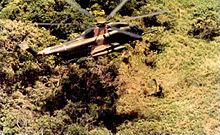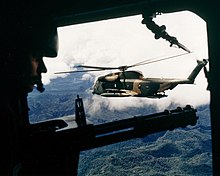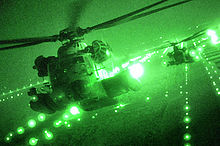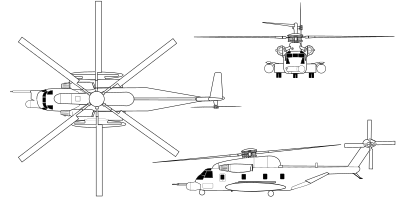Shes 53
| HH-53 "Super Jolly Green Giant" MH-53 Pave Depression | |
|---|---|
 | |
| A MH-53 Pave Low from the 20th Special Operations Squadron at Hurlburt Field, Florida | |
| Function | Heavy-lift helicopter |
| Manufacturer | Sikorsky Aircraft |
| First flight | 15 March 1967 |
| Introduction | 1968 |
| Retired | 30 September 2008 |
| Status | Retired[1] |
| Primary user | The states Air Force |
| Produced | 1967–1970 |
| Number congenital | 72[2] |
| Adult from | Sikorsky CH-53 Sea Stallion |
The Sikorsky MH-53 Pave Depression series is a retired long-range special operations and combat search and rescue (CSAR) helicopter for the Us Air Force. The series was upgraded from the HH-53B/C, variants of the Sikorsky CH-53 Sea Stallion. The HH-53 "Super Jolly Greenish Giant" was initially developed to supersede the HH-3E "Jolly Green Giant". The U.S. Air Forcefulness's MH-53J/Grand fleet was retired in September 2008.[1]
Design and development [edit]
The The states Air Force ordered 72 HH-53B and HH-53C variants for Search and Rescue units during the Vietnam War, and later developed the MH-53J Pave Low version for Special Operations missions.
The Pave Low's mission was low-level, long-range, undetected penetration into denied areas, day or night, in adverse atmospheric condition, for infiltration, exfiltration and resupply of special operations forces. Pave Lows often worked in conjunction with MC-130H Gainsay Talon for navigation, communications and gainsay back up,[3] and with MC-130P Combat Shadow for in-flight refueling.[iv] [5]
The large green airframe of the HH-53B earned information technology the nickname "Super Jolly Dark-green Giant". This proper noun is a reference to the smaller HH-3E "Jolly Light-green Giant", a stretched variant of the H-iii Ocean King, used in the Vietnam War for combat search-and-rescue (CSAR) operations.
HH-53B [edit]
The US Air Forcefulness regarded their Sikorsky S-61R/HH-3E "Jolly Green Giant" long-range CSAR helicopters favorably and was interested in the more capable S-65/CH-53A. In 1966, the USAF awarded a contract to Sikorsky for development of a CSAR variant of the CH-53A.[vi]

The HH-53B, as information technology was designated, featured:
- A retractable in-flight refueling probe on the correct side of the nose
- Spindle-shaped jettisonable external tanks with a capacity of 650 US gallons (two,461 L), fitted to the sponsons and braced by struts fastened to the fuselage
- A rescue hoist above the correct passenger door, capable of deploying a woods penetrator on 250 feet (76 k) of steel cable
- Armament of 3 pintle-mounted General Electric GAU-2/A 7.62 mm (.308 in) six-barreled Gatling-blazon machine guns, with 1 in a forward hatch on each side of the fuselage and one mounted on the tail ramp, with the gunner secured with a harness
- A total of i,200 pounds (540 kg) of armor
- A Doppler navigation radar in the forward belly
Early HH-53Bs featured T64-GE-3 turboshafts with three,080 shaft horsepower (2,297 kW) each, simply these engines were later upgraded to T64-GE-seven turboshafts with iii,925 shaft horsepower (2,927 kW). V crew were standard, including a airplane pilot, copilot, crew chief, and two pararescuemen.[6]
HH-53C [edit]

An HH-53C lowering a PJ during a rescue mission, June 1970
The HH-53B was essentially an acting type, with production apace moving on to the modestly improved Air Force HH-53C CSAR variant. The most visible difference between the HH-53B and HH-53C was that the HH-53C dispensed with the fuel-tank bracing struts. Experience with the HH-53B showed that the original tank was too big, adversely affecting operation when they were fully fueled, and so a smaller 450 Usa gal (1,703 Fifty) tank was adopted in its place. Other changes included more armor and a more than comprehensive suite of radios to improve communications with C-130 tankers, attack aircraft supporting CSAR deportment, and aircrews awaiting rescue on the ground. The HH-53C was otherwise much like the HH-53B, with the more powerful T64-GE-vii engines.[6]

A HH-53 seen from the gunner's position of a helicopter over Vietnam in October 1972
A total of 44 HH-53Cs were built, with introduction to service in August 1968. Late in the war they were fitted with countermeasures pods to deal with heat-seeking missiles. As with the HH-53B, the HH-53C was as well used for covert operations and snagging reentry capsules, likewise as snagging reconnaissance drones. A few were assigned to support the Apollo space program, standing past to recover an Apollo capsule in example of a launchpad arrest, though such an accident never happened.[6]
In addition to the HH-53Cs, the Air Force obtained 20 CH-53C helicopters for more general transport piece of work. The CH-53C was patently very like to the HH-53C, fifty-fifty retaining the rescue hoist, the most visible deviation being that the CH-53C did non have an in-flight refueling probe. Since CH-53Cs were used for covert operations, they were armed and armored like HH-53Cs.[6] A good number of Super Jollies were converted into Pave Low special-operations helicopters.[half-dozen] PAVE or Pave is an Air Force code name for a number of weapons systems using advanced electronics.
HH/MH-53H [edit]
The USAF'southward Super Jollies were useful helicopters, but they were essentially daylight / fair weather machines, and downed aircrew were oftentimes in problem at night or in bad atmospheric condition. A express nighttime / foul weather sensor system designated "Pave Depression I" based on a low-light-level Television set (LLLTV) imager was deployed to Southeast Asia in 1969 and gainsay-evaluated on a Super Jolly, but reliability was not adequate.[6]
In 1975, an HH-53B was fitted with the much improved "Pave Depression II" organization and re-designated YHH-53H. This practice proved much more satisfactory, and so eight HH-53Cs were given a farther improved systems fit and redesignated HH-53H Pave Depression Three, with the YHH-53H besides upgraded to this specification. All were delivered in 1979 and 1980.[6]
The HH-53H retained the in-flight refueling probe, external fuel tanks, rescue hoist, and three-gun ammunition of the HH-53C; armament was typically a minigun on each side, and a Browning .50 in (12.7 mm) gun in the tail to provide more than reach and a lite anti-armor adequacy. The improvements featured by the HH-53H included:
- A Texas Instruments AN/AAQ-10 forward-looking infrared (FLIR) imager.
- A Texas Instruments AN/APQ-158 terrain-following radar (TFR), which was a digitized version of the radar used past the A-7. It was farther modified to exist able to give terrain abstention and terrain following commands simultaneously (kickoff shipping capable of this unique feature).[ citation needed ]
- A Canadian Marconi Doppler-radar navigation system.
- A Litton or Honeywell inertial guidance arrangement (INS).
- A computerized moving-map display.[6]
- A radar-warning receiver (RWR) and chaff-flare dispensers.
The FLIR and TFR were mounted on a distinctive "mentum" mountain. The HH-53H could be fitted with 27 seats for troops or 14 litters. The upgrades were performed by the Navy in Pensacola, reflecting the fact that the Navy handled high-level maintenance on Air Force S-65s. In 1986, the surviving HH-53Hs were given an upgrade nether the Abiding Light-green program, featuring incremental improvements such as a cockpit with blue-dark-green lighting uniform with night vision goggles (NVGs). They were and then reclassified as "special operations" machines and accordingly given a new designation of MH-53H.[6]
The HH-53H proved itself and the Air Strength decided to order more than, coming up with an MH-53J Pave Low Three Enhanced configuration. The full general configuration of the MH-53J is like to that of the HH-53J, the major alter existence fit of twin T64-GE-415 turboshafts with 4,380 shp (3,265 kW) each, also as more than armor, giving a full armor weight of 1,000 lb (450 kg). There were some avionics upgrades also, including fit of a mod Global Positioning System (GPS) satellite navigation receiver. A full of 31 HH-53Bs, HH-53Cs, and CH-53Cs were upgraded to the MH-53J configuration from 1986 through 1990, with all MH-53Hs upgraded too, providing a total of 41 MH-53Js.[6]
MH-53J/Thou [edit]


The MH-53J Pave Low 3 helicopter was the largest, well-nigh powerful and technologically advanced send helicopter in the U.s.a. Air Forcefulness inventory. The terrain-following and terrain-avoidance radar, forward looking infrared sensor, inertial navigation system with Global Positioning System, along with a projected map display enable the crew to follow terrain contours and avoid obstacles, making low-level penetration possible.
Under the Pave Low III plan, the Air Force modified nine MH-53Hs and 32 HH-53s for night and adverse weather condition operations. Modifications included AN/AAQ-18 forward-looking infrared, inertial navigation system, global positioning system, Doppler navigation systems, APQ-158 terrain-following and terrain-avoidance radar, an on-lath mission computer, enhanced navigation system, and integrated avionics to enable precise navigation to and from target areas. The Air Force designated these modified versions equally MH-53J.
The MH-53J'due south main mission was to driblet off, supply, and pick up special forces behind enemy lines. It also tin appoint in combat search and rescue missions. Low-level penetration was made possible past a state-of-the-art terrain following radar, every bit well every bit infrared sensors that allow the helicopter to operate in bad conditions. It was equipped with armor plating. It could transport 38 troops at a fourth dimension and sling up to twenty,000 pounds (nine,000 kg) of cargo with its external claw. It was capable of a top speed of 165 mph (266 km/h) and had a ceiling of sixteen,000 feet (4,900 grand).
The MH-53M Pave Low Iv was modified from the MH-53J configuration with the addition of Interactive Defensive Avionics System/Multi-Mission Advanced Tactical Last or IDAS/MATT. The organization enhanced the defensive capabilities of the Pave Low. It provided instant access to the total battlefield situation, through almost real-fourth dimension Electronic Order of Battle updates. It also provided a new level of detection avoidance with near real-time threat broadcasts over-the-horizon, so crews can avoid and defeat threats, and replan en road if necessary.
Operational history [edit]
While waiting for delivery of the HH-53Bs, the Air Force obtained two Marine CH-53As for evaluation and training. The first of eight HH-53Bs performed its initial flying on 15 March 1967, and the blazon was performing CSAR missions with the USAF Aerospace Rescue & Recovery Service in Southeast Asia by the finish of the year. The Air Force chosen the HH-53B the "Super Jolly". It was used for CSAR, covert combat operations, and "snagging" reentry capsules from photo-reconnaissance satellites.[6]
The Air Force lost 17 Super Jollies during the Southeast Asia conflict, with 14 lost in combat – including one that was shot downwards by a North Vietnamese MiG-21 on 28 January 1970 while on a CSAR mission over Laos – and three lost in accidents.[six] The Super Jollies made headlines in November 1970 in the unsuccessful raid into Due north Vietnam to rescue prisoners-of-war from the Son Tay prison campsite, too every bit in the operation to rescue the crew of the freighter SS Mayagüez from Cambodian Khmer Rouge fighters in May 1975.
The HH-53B, HH-53C, and CH-53C remained in Air Force service into the belatedly 1980s. Super Jollies operating in front-line service were painted in various cover-up color schemes, while those in stateside rescue service were painted in an overall gray scheme with a yellowish tailband.[vi]
The first 9 HH-53H Pave Lows became operational on one July 1980, and were transferred from the Military Airlift Command, where they were to have been CSAR avails, to the 1st Special Operations Wing in the aftermath of the Operation Eagle Claw disaster. 2 of the HH-53Hs were lost in grooming accidents in 1984, and and then 2 CH-53Cs were brought up to HH-53H standard equally replacements.[6]
Five MH-53Js of the 20th Special Operations Squadron deployed to Panama as part of Operation But Crusade in December 1989. During the performance, MH-53Js conducted missions including reconnaissance, small squad insertion, medivac, logistics, and burn down back up. The MH-53's terrain-following and terrain-avoidance radar, forth with GPS, enabled the helicopters to reach objectives other helicopters could not; in i case, an MH-53 used its precision navigation capability to pb a SEAL team on MH-6 Trivial Bird helicopters to their remote objective. 20th SOS crews flew 193 sorties during the operation, totaling 406.1 hours of flight time.[7]
The MH-53 Pave Depression's last mission was on 27 September 2008, when the remaining half dozen helicopters flew in support of special operations forces in Western asia. These MH-53Ms were retired shortly thereafter and replaced with the V-22 Osprey.[1] [8] [9]
Variants [edit]

MH-53 Pave Lows fly over Republic of iraq on their final combat missions in September 2008, before their retirement.
- TH-53A – preparation version used past US Air Force (USAF)
- HH-53B – CH-53A type for USAF search and rescue (SAR)
- CH-53C – heavy-elevator version for USAF, 22 built
- HH-53C – "Super Jolly Dark-green Giant", improved HH-53B for USAF
- YHH-53H – paradigm Pave Low I aircraft
- HH-53H – Pave Low II night infiltrator
- MH-53H – redesignation of HH-53H
- MH-53J – "Pave Depression III" special operations conversions of HH-53B, HH-53C, and HH-53H.
- MH-53M – "Pave Low 4" upgraded MH-53Js
For other H-53 variants, meet CH-53 Sea Stallion, CH-53E Super Stallion and CH-53K King Stallion.
Operator [edit]
-
 The states
The states
- United States Air Forcefulness[10]
Shipping on display [edit]

- MH-53M Pave Low IV, AF series number 68-10928, was retired 29 July 2007 and placed on display at Air Commando Park, Hurlburt Field, Florida on three December 2007. This helicopter took function in the May 1975 Mayagüez incident rescue operation and sustained major battle damage to the engine, rotor blades, and instrument panel. The aircraft flew in combat in Afghanistan and Republic of iraq for its terminal 7 years of service, completing its last gainsay mission in Republic of iraq during the summer 2007.[11]
- MH-53M Pave Depression 4, AF serial number 68-10357, was retired in March 2008 and placed on display at the National Museum of the US Air Forcefulness at Wright-Patterson AFB, Ohio on 8 July 2008. This MH-53 carried the command element during Operation Ivory Coast, the mission to rescue American prisoners of state of war from the Son Tay North Vietnamese prison camp in 1970.[ii]
- MH-53M Pave Low IV, AF serial number seventy-1626, was retired eleven August 2008 and will be placed on brandish at the Museum of Aviation, Robins AFB, Georgia.[12]
- MH-53M Pave Low IV, AF serial number 68-8284, was retired on thirty September 2008 and arrived at the Cold State of war Exhibition at the Royal Air Forcefulness Museum, RAF Cosford, UK on 17 December 2008.[thirteen]
- MH-53M Pave Depression Four, AF serial number 73-1652, was retired 5 September 2008 and placed on display at the Air Force Ammunition Museum next to Eglin AFB. This MH-53M was involved in operations soon after the Jonestown Massacre.[14]
- MH-53M Pave Depression IV, AF serial number 73-1649. It was retired and intended for a museum when it erroneously ended upwardly in the "Boneyard" of the 309th Aerospace Maintenance and Regeneration Grouping. Its last dedicated Crew Main discovered it and "rescued" it. It is on display at the Pima Air & Space Museum.[fifteen] [16]
- MH-53M Pave Depression IV, AF serial number 69-5785, on display at Maxwell AFB. Information technology was dedicated on June 8, 2009, and is in the base's Air Park.[17]
- MH-53J Pave Depression III, AF serial number 66-14433, on display at Kirtland AFB. This shipping was the prototype for the Pave Low III configuration. It was the commencement H-53 to accomplish 10,000 flight hours.[18]
- MH-53M Pave Low Iv, AF serial number 68-10369, was retired in September 2008 and is now on display at Hill Aerospace Museum.[nineteen]
Specifications (MH-53J) [edit]


MH-53 Pave Lows ready to accept off for their final gainsay mission on 27 September 2008, in Iraq.
Data from USAF MH-53J/M,[20] International Directory,[21] Vectorsite[22]
General characteristics
- Crew: 6 (two pilots, two flight engineers and two aerial gunners)
- Capacity: 37 troops (55 in alternate configuration)
- Length: 88 ft (27 g)
- Height: 25 ft (7.6 1000)
- Empty weight: 32,000 lb (14,515 kg)
- Max takeoff weight: 46,000 lb (xx,865 kg) normal
-
-
-
- l,000 lb (23,000 kg) fortime emergency
-
-
- Powerplant: ii × Full general Electric T64-GE-100 turboshaft engines, four,330 shp (iii,230 kW) each
- Main rotor diameter: 72 ft 0 in (21.95 grand)
Operation
- Maximum speed: 170 kn (200 mph, 310 km/h)
- Cruise speed: 150 kn (170 mph, 280 km/h)
- Range: 600 nmi (690 mi, 1,100 km) can be extended with in-flight refueling
- Service ceiling: xvi,000 ft (four,900 m)
Armament
- Guns: * Whatever combination of three 7.62×51mm NATO M134 Miniguns and/or 12.7×99mm NATO (.fifty BMG) M2 Browning car guns mounted on left and right sides (immediately behind flight deck) and ramp
Notable appearances in media [edit]
See also [edit]
Related development
- CH-53 Bounding main Stallion
- CH-53E Super Stallion
- HH-3E "Jolly Green Giant"
Shipping of comparable role, configuration, and era
- MH-47 Chinook
- Sikorsky HH-sixty Pave Hawk
Related lists
- Listing of active United States armed forces aircraft
- List of rotorcraft
References [edit]
- ^ a b c "MH-53s wing concluding combat missions". Us Air Force, 1 October 2008.
- ^ a b Bardua, Rob. "New MH-53M helicopter exhibit opens at the National Museum of the U.South. Air Forcefulness" Archived 2008-07-23 at the Wayback Machine. USAF National Museum, 8 July 2008.
- ^ MC-130E/H Combat Talon I/Ii Fact Sail, US Air Force.
- ^ MC-130P Combat Shadow Fact Sheet, US Air Strength.
- ^ MH-53J page. Globalsecurity.org
- ^ a b c d due east f thou h i j grand l chiliad n o "vectorsite.internet". www1.vectorsite.net . Retrieved ix February 2019.
- ^ Whitcomb, Darrel D. (2012). On a Steel Equus caballus I Ride: A History of the MH-53 Pave Low Helicopters in War and Peace (PDF). Montgomery, Alabama: Air University Press. pp. 265–274. ISBN978-i-58566-220-three.
- ^ Whitcomb, D.D. (2012). On a Steel Horse I Ride: A History of the MH-53 Pave Low Helicopters in War and Peace. Maxwell Air Force Base, AL: Air Academy Press, Air Force Research Institute.
- ^ "Bye-Bye Pave Low, Hello Osprey". Military.com. 8 October 2008.
- ^ "USAF". helis.com. Retrieved 5 January 2013.
- ^ Hurlburt Field, MH-53 Pave Low Archived 2011-07-28 at the Wayback Machine, Fact Sheet, retrieved 24 March 2012
- ^ Purser, Becky. "Celebrated combat search and rescue helicopter finds new home at Robins" [ permanent expressionless link ] . macon.com
- ^ Willetts, Richard. "RAF Cosford MH-53 Delivery Characteristic Report, 17 Dec 2008" Archived 17 June 2009 at the Wayback Auto
- ^ Getlin, Noel, Hurlburt MH-53 flies last mission to where information technology is displayed at the Air Forcefulness Armament Museum v September 2008, Eglin Dispatch
- ^ "PAVE Low IV". world wide web.pimaair.org . Retrieved 9 February 2019.
- ^ ""Restoration of a Jolly Green, Davis-Monthan Air Forcefulness Base News"". Archived from the original on 16 December 2013.
- ^ Berquist, Carl. "Maxwell dedicates veteran MH-53 to Air Park". Air University. Archived from the original on 22 April 2014. Retrieved 22 April 2014.
- ^ McCune, Christopher. "Kirtland AFB's MH-53J Pave Low - a historic pioneer". Retrieved xix Jan 2017.
- ^ Hill Aerospace Museum (2021). "MH-53M Pave Depression IV". aerospaceutah.org. Archived from the original on 16 April 2021. Retrieved sixteen April 2021.
- ^ MH-53J/M PAVE LOW fact sheet. US Air Force, October 2007.
- ^ Frawley, Gerard: The International Directory of Military Shipping, p. 152. Aerospace Publications Pty Ltd, 2002. ISBN 1-875671-55-2.
- ^ USAF PAVE Low: HH-53H / MH-53H, MH-53J, MH-53M, TH-53A. Vectorsite.net, ane April 2009.
External links [edit]
The initial version of this article was based on a public domain article from Greg Goebel's Vectorsite.
- USAF MH-53 page (archived)
- USAF MH-53 PAVE LOW site
- HH-53, MH-53J Pave Low Three, and MH-53M Pave Depression IV pages on GlobalSecurity.org
Source: https://en.wikipedia.org/wiki/Sikorsky_MH-53
0 Response to "Shes 53"
Post a Comment